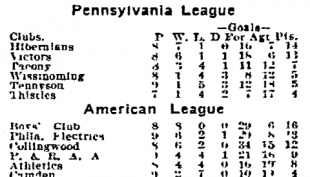The title race in Philadelphia’s professional Pennsylvania League was continuing to heat up after Hibernian topped Victors on Jan. 5, 1913. Hibernian continued their good form on Jan. 12 with a 2–0 win over long-standing rivals Tacony, now sitting in third place. With the win, the Hibs moved Victors out of first place for the first time that season. The Inquirer wrote on Jan. 13, “Unless there is a big reversal in the form of the Hibernians in their next two league games they should just about nose out the Victors for the pennant in the Pennsylvania League…The Victors are bent on keeping right at the heels of the Irishmen and should the latter drop one point and the Victors win all of their remaining games the two teams will finish a tie, which would necessitate a play-off for the championship.”
Despite the loss to Hibernian, the Inquirer still praised the improved play of Tacony. Looking ahead, the Inquirer said Tacony “should make it interesting when the Hibernians tackle them in the semi-final round of the American Football Cup tourney,” which would be taking place on March 15.
 In the city’s amateur American League, Boys’ Club continued their unbeaten run with a 2–1 win over the Pennsylvania & Reading Rail Road Athletic Association. Still, the Inquirer saw improvement in the league and said “it would not be at all surprising if the Boys’ Club had their colors lowered by one of the contenders as they all appear to be evenly balanced.”
In the city’s amateur American League, Boys’ Club continued their unbeaten run with a 2–1 win over the Pennsylvania & Reading Rail Road Athletic Association. Still, the Inquirer saw improvement in the league and said “it would not be at all surprising if the Boys’ Club had their colors lowered by one of the contenders as they all appear to be evenly balanced.”
In other American League play, Athletics moved within one point of fourth place P. & R. A. A. with a surprising 3–0 win over third place Collingwood.
In the Allied American League, Bethlehem continued their dominating 12-game unbeaten run with a commanding 6–1 thrashing of Reading. But the Inquirer reserved its praise for sixth place Peabody’s 4–0 win over fourth place Smith A.A. “The team is composed of sturdy young players who play the game in the proper spirit, and those who have to meet them in the Allied First Division will have to possess the goods to lower their colors.”
Philadelphia Challenge Cup
On Jan. 18, Hibernian and Boys’ Club would meet in Philadelphia Challenge Cup play. The Inquirer wrote in their match preview on that day, “There should be one of the fastest matches of the season this afternoon when the Hibernians and Boys’ Club meet in the second round of the Philadelphia Challenge Cup tourney at Second street and Allegheny avenue. The Boys’ Club have not yet lost a contest this season and as recently as Christmas morning they defeated the Hibernians in an exhibition game.” Also meeting in the Challenge Cup would be Philadelphia Athletics and Camden.
Because of the tournament, no Pennsylvania League games were scheduled and only one American League game was on the calendar. But each of the city’s other leagues had plenty of games on tap, including the debut of play in the United League.
New league formed
On Jan. 8, 1913, the Philadelphia Inquirer reported that a new league had been formed in the city.
“At one of the most enthusiastic meetings ever held at The Inquirer office among the soccermen, the ‘United League’ was made a permanent organization last night with the election of officers and the make-up of the circuit was decided upon.”
The Inquirer noted that all of the clubs had “paid their entrance money which insures the league one of the strongest circuits in this section of the country from an amateur standpoint.”
The strong circuit would be made up of 12 teams—among them Frankford Boys’ Club, American Pulley Company, Whitehall Rovers, P.H.L., Roxborough United, Erie AC, Vincome, Christ Church, Logan, and North Philadelphia YMA— with league play scheduled to start on Jan. 18. And while the league was amateur—the players weren’t paid for playing—that didn’t mean there wasn’t money to be made. As the Inquirer reported, “Any receipt accruing from the gate will be divided between the two competing teams after expenses have been paid.”
A strange rash of broken legs
On Jan. 13, the Inquirer wrote, “Here of late in the last eight days there have been a greater number of serious injuries sustained on the soccer field than what has occurred in the last fifteen years, and, strange to say, the injuries have all been broken legs.” The report described four broken legs, three of which happened in games, one in a practice. Interestingly, two of the players who had suffered game-time broken legs, E. Thomas of Peabody and Belmont’s Callahan, did so after coming “into contact” with the same player, one Charlie Masson of West Philadelphia FC in the Allied American League first division.
In a separate article on Jan. 13, the Inquirer noted that Oliver Hemingway, secretary of the Allied American League, would be leading a delegation to meet with representatives of the city’s American League in order to induce the league to allow Boys’ Club, provided the latter is willing, to play a benefit game Ernest Thomas of Peabody.” The report continued, “It is planned by the Allied magnates to select a team to meet the Boys’ Club rather than have West Philadelphia tackle Bethlehem, as was previously arranged.”


Comments